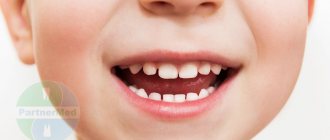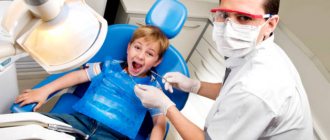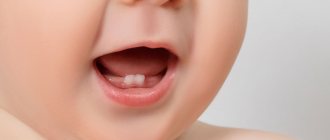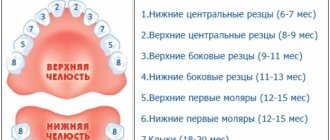The replacement of baby teeth with permanent ones is a natural physiological process that every child experiences. It usually begins in preschool age and proceeds without difficulty. But parents need to approach it responsibly, since any violations when changing teeth are fraught with unpleasant consequences. This may be the formation of a malocclusion, uneven teeth, or the occurrence of a diastema (interdental gap).
In this article we will consider the correct sequence of tooth replacement, possible violations, and situations when consultation with a pediatric dentist is necessary.
Why and when do baby teeth change?
As the child grows, the dentofacial apparatus also develops. At approximately 4–6 years of age, the preparatory stage begins, during which interdental spaces appear. This prepares the place for permanent teeth in the primary dentition.
The process of replacing baby teeth with permanent teeth is a slow process, taking approximately 6 or 7 years (until adolescence). Active growth of the roots of permanent teeth activates the process of bone resorption - this is the destruction (dissolution) of milk roots, which leads to loosening and tooth loss. Standard diagram of the sequence of changing baby teeth in a child.
- Central lower incisors (5–7 years). They fall out one by one with a short time interval.
- Lateral incisors (7–8 years).
- First molars on the upper jaw, second molars on the lower jaw (9–11 years)
- Cone-shaped teeth (canines) at the age of 9–12 years.
- Second molars on the upper jaw and first molars on the lower jaw (10–13 years)
Not everyone's third molars (wisdom teeth) erupt. This is considered the norm. Most often, the optimal age for them is considered to be from 17 to 25 years.
Reference!
The later the first teeth erupted in infancy, the later they will be replaced in preschool age.
By the age of 15–16, a teenager’s permanent bite should number 28 units.
At what age do radical units appear?
We can talk about adult occlusion only a few years after the start of the change in time units. Typically, a stronger replacement will erupt several weeks or months (or, if pulled out prematurely, years) after the baby teeth fall out.
Central incisors grow from 6 to 8 years of age, lateral incisors from 7 to 9, premolars and canines from 9 to 12. Molars begin to grow at approximately six years of age. They immediately grow permanently, replacing the empty space.
What deviations from the norm may there be?
Each child develops individually. Sometimes the timing of the replacement of certain teeth may differ from the generally accepted norm. Minor deviations are allowed up to 12 months. But sometimes the change in the primary bite begins too early or, on the contrary, the temporary teeth do not want to fall out.
Causes:
- long-term breastfeeding;
- severe infectious diseases in infancy;
- pathologies of intrauterine development.
Reference!
Dentists believe that a safer deviation is a late change in the primary occlusion than vice versa.
Let us consider in detail the common violations and their causes.
Early tooth loss
We can talk about such a pathology if a child’s baby teeth begin to fall out before the age of 5. Possible reasons:
- advanced multiple caries;
- injury;
- gum disease;
- manual loosening of the tooth.
In all these cases, consultation with a pediatric dentist is required.
Important!
Parents should record the time of tooth loss. If after 4 months the permanent tooth does not begin to emerge, then the help of a doctor is required.
In case of early unnatural tooth loss, it is advisable to conduct an X-ray diagnosis. This will help to identify possible damage to the permanent root rudiment in time and begin treatment. Otherwise, the child will need prosthetics in the future.
Late change from primary to permanent occlusion
The deadline for starting the process of changing baby teeth is 8 years. But this is considered a late shift. The disorder may be caused by:
- heredity;
- metabolic disorders;
- infectious diseases suffered in early childhood;
- mental disorders.
If after 8 years a child has not lost a single baby tooth, this is a reason to consult a doctor.
X-ray of the jaw in children
Problems with teeth, as well as with the development of bite, begin to bother a person from a very early age. Pediatricians constantly monitor the teething process in very young children. Parents can also seek advice from pediatric dentists if there is a suspicion that something is going wrong.
A procedure such as an x-ray of a child’s jaw is prescribed quite often today. There is no need to be afraid that X-rays can negatively affect the child’s health - the modern equipment used for the study is characterized by minimal radiation exposure. X-ray can be considered a safe diagnostic method.
Reasons for late eruption
Normally, after a baby tooth falls out, it takes 1-2 months for the permanent tooth to erupt. This is the longest period. In most cases, the rudiments of a permanent tooth can already be seen at the site of the lost tooth.
But, if a child’s toothless smile persists for 3 months or more, then this is a cause for concern for parents.
Let's consider why such dental pathology occurs:
- Retention
– a common condition that mainly affects the incisors and canines. They cannot erupt due to dense gums or because they rest against neighboring teeth. There are complete and partial retention. With the full form, a healthy root is visible in the picture, but it is completely under the gum. With partial retention, only part of the crown is visible. In this case, surgical assistance is required.
- Edentia
– a congenital pathology in which there is a lack of rudiments of permanent dental units. Can be complete or partial (sparse teeth). A rare disease. Orthopedic treatment is required as early as possible.
- Impact
– delayed eruption in this pathology is associated with a mechanical obstacle, that is, the child has a supernumerary of dental units. In this case, the permanent root simply does not have room to erupt. Impaction can only be detected using a panoramic x-ray of the jaw.
The sooner the child is examined by a doctor, the higher the chance of having an even and complete dentition.
Which teeth should an eight-year-old child have?
Every child who has reached the age of eight should normally have the following permanent teeth - 4 lower and 4 upper incisors, sixth molars. Sometimes there may be individual deviations in teething within plus or minus six months.
Why is it necessary to treat caries in childhood if you then have to remove baby teeth with filled roots?
If an empty space forms in the dentition, this contributes to the fact that the remaining milk teeth shift, and along with them, the rudiments of permanent teeth also shift and they begin to grow incorrectly under them - in one place the formation of cracks begins, and in another - the teeth fit alone another. A filled, treated baby tooth will save space for a permanent tooth. Untreated teeth infect the rudiments of permanent teeth with infection, which causes their deformation and even complete absence.
Possible problems when changing baby teeth
Common dental pathologies when changing a primary dentition to a permanent one include:
- Shark teeth. A phenomenon in which baby and permanent teeth are located parallel to each other, in 2 rows. This arrangement can interfere with the normal development of the dental system. But in most cases, the temporary root becomes loose, and the “extra” tooth falls out on its own. If this does not happen, removal at the doctor's office is recommended.
- Increased pain. Sometimes a change in the milk bite is accompanied by increased body temperature, redness of the gums and severe pain. These symptoms usually accompany early or late change of teeth. Inflammatory diseases of the oral cavity may also be the cause.
- The appearance of a hematoma.
In rare cases, when molars erupt, a hematoma occurs on the gum in the form of a small bubble with an accumulation of blood. This occurs due to severe eruption, which leads to rupture of blood vessels. The gums may be pale in color. Pain and discomfort occurs. If suppuration occurs, medical attention is required.
If pathological phenomena do not go away for a long time, and the child is irritable and complains of pain, be sure to visit the dentist.
Why can a 7-14 year old child sometimes experience pain when all his teeth are intact?
Yes, this can happen, but in this case the pain occurs not in the tooth itself, but in the jaw, which is growing rapidly at this age. Since permanent teeth are almost twice as large as baby teeth, they need much more space. Therefore, large new teeth can sometimes overlap each other or grow at an angle, getting out of the dentition. As the jaw grows, they align and settle into place. But a qualified specialist can competently assess this situation, as well as the risk of anomalies and developmental defects. That is why in this case you will need to consult an orthodontist.
What not to do when baby teeth fall out
Incorrect actions of children and parents can lead to the formation of malocclusion, increased pain, or the formation of crooked teeth. To avoid this, it is recommended to adhere to the following rules:
- Don't help baby teeth fall out if they are straight and not loose. Even if, according to the child’s age, it is high time for him to have a toothless smile.
- Don't loosen your teeth with your hands. And do not pull them at home, for example, with a thread.
- Baby teeth are quite fragile in preschool age. Therefore, your child should not indulge in solid foods. The crown may break, but the root will remain in the gum.
- If a tooth falls out, do not allow your child to touch the socket with his tongue or hands. Gentle rinsing with antiseptic solutions or herbal decoctions is recommended.
If you have a fever, cough or lethargy, do not rush to resort to antiviral drugs. Poor health can be a harbinger of the imminent change of baby teeth.
What to do if a tooth does not fall out in time
According to statistics, in 20-30% of cases, children experience a “shark smile” when the permanent tooth has already erupted and is growing, but the milk tooth has not yet fallen out. Clinical studies have proven that in such a situation, parents should not hesitate to go to pediatric dentistry. The doctor will carefully examine your child's mouth and remove the temporary tooth. If you do not contact the dentist in a timely manner, double dentition can lead to improper formation of the bite, impaired diction and the functioning of the digestive system. In addition, with a “shark smile” it is difficult for a baby to bite and chew food, particles of which remain between the teeth and under the gum. As a result, inflammatory processes and caries occur. All this can be avoided by making an appointment with a specialist.
Tips for parents
During the period of teeth change, you should enrich your baby’s food with foods that are rich in calcium. To prevent inflammation in your mouth, make it a habit to rinse your mouth every time you eat or have a snack. As permanent teeth erupt, offer your baby soft or liquid foods. Avoid hot drinks.
If slight bleeding occurs when a baby tooth falls out, do not use alcohol tinctures. Apply a cotton ball to the wound and do not allow food for 2 hours. In order to promptly identify possible irregularities in the eruption of the permanent dentition, it is recommended to record the date of baby tooth loss.
Beautiful, straight and healthy teeth in adults are the result of proper care in childhood. Therefore, parents should teach their child proper oral hygiene from the first tooth.
How to relieve your baby's condition
Many young parents are wondering how to relieve the unpleasant symptoms that accompany the “birth” of milk units. The simplest measure is to apply cold (a piece of ice) to the “working” gum. Dental gels or ointments can also come to the rescue, relieving pain, swelling, and stopping the inflammatory process. Important: any medications should be used only with the permission of a pediatrician (pediatric dentist).
Thus, pharmacies sell special gels with lidocaine and inert fillers (menthol, astringents, flavorings) intended for use exclusively during teething. Examples of such tools:
- Kalgel (contraindicated for diathesis).
- Dentinox.
- Kamistad.
- Holisal.
- Mundizal.
General recommendations for use: a small amount of the local drug should be applied to the “working gums” 3-4 times a day for no longer than 3 days in a row.
Decoding the results
The finished images must be deciphered by a specialist. It is possible that several doctors will be present during the decoding, for example a radiologist
, dentist, otolaryngologist.
The photographs are used to assess how symmetrically the teeth and jaws are positioned. If a focus of any pathology is detected, it is important to determine its exact location and size.
When diagnosing a jaw fracture, you need to determine its complexity, consider whether there are fragments and how they are located.
If a tumor-like neoplasm is detected, it is important to assess its size, consider its boundaries (clear or blurred), and determine its location.









